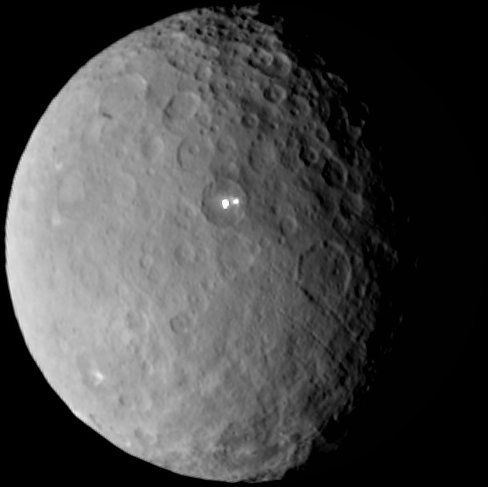PROVIDENCE, R.I. [Brown University] — NASA’s Dawn spacecraft has become the first satellite to orbit a dwarf planet. On Friday, March 6, Dawn began orbiting Ceres, the largest inhabitant of the asteroid belt between Mars and Jupiter. Scientists are hopeful that the icy orb, nearly 600 miles (1,000 kilometers) in diameter, will reveal critical clues about the formation of the early solar system.
“Ceres is going to be a phenomenal place,” said Carle Pieters, a planetary scientist at Brown and a co-investigator on the mission. “We’re really excited about the next couple of months.”
Ceres is the second and final stop on Dawn’s journey of nearly 3 billion miles (5 billion kilometers). In 2011, the spacecraft spent 14 months orbiting the asteroid Vesta, the second-largest asteroid belt object. The two bodies share the same neighborhood, and both appear to have been on their way to becoming planets before Jupiter’s gravity stunted their growth. But they differ in important ways, Pieters says, and they have different stories to tell about the early solar system.
Vesta is closer to the sun and is thought to have formed before Ceres, when the nascent solar system was rich in short-lived radiogenic elements. Heat from the sun and those elements would have helped burn off any water and other volatile compounds as Vesta was forming, leaving it dry and rocky. Ceres, on the other hand, is thought to have formed farther from the sun, and millions of years later when there were fewer radiogenic elements. That cooler environment enabled Ceres to hold on to its water.
Indeed, measurements of Ceres’s density suggest that its composition is as much as 25 percent ice, according to most models. Most of that water is thought to be in the outer layers of Ceres, surrounding a rocky core. One of Dawn’s objectives will be to look for signs that a liquid water ocean may have once existed beneath Ceres’ frozen outer shell.
Dawn will circle Ceres for the next year or so to map surface topography, scan mineral and elemental composition, and look for active geological processes on the surface. The spacecraft will come within a few hundred miles of the surface, enabling its cameras to photograph Ceres with up to 35-meter resolution.
But even before entering orbit, Dawn was turning up surprises. During its approach, navigation cameras captured images of Ceres at resolution many times higher than any images captured by Earth-based telescopes. The images show a body battered by impacts and with no shortage of interesting geology. But what really captured scientists’ attention were two mysterious bright spots on Ceres’ northern hemisphere. Nobody is quite sure what those features might be, Pieters says, but there are plenty of hypotheses.
They could be evidence of recent impacts that churned up pristine, highly reflective ice hiding just below Ceres’s weathered surface. Or maybe they’re plumes of water vapor similar to a plume that was glimpsed a few years ago by the Herschel Space Observatory. It’s all just speculation at this point, Pieters says. More definitive answers will have to wait until Dawn starts returning data from orbit sometime in mid-April.
“The really good stuff will be coming down in the summer,” Pieters said. “That’s when things are going to start getting really exciting. So stay tuned.”

